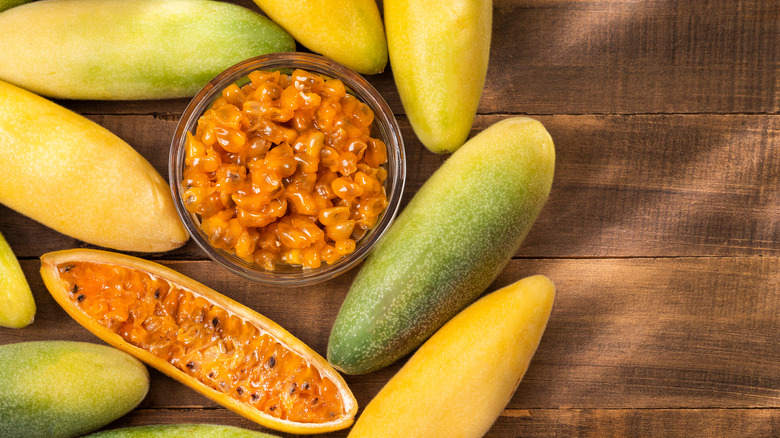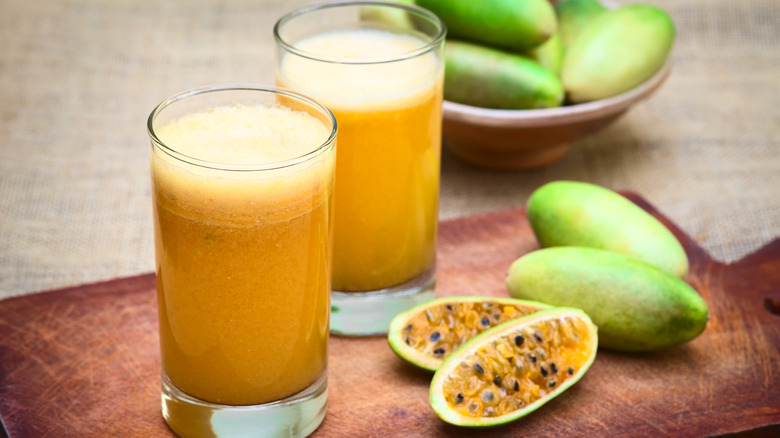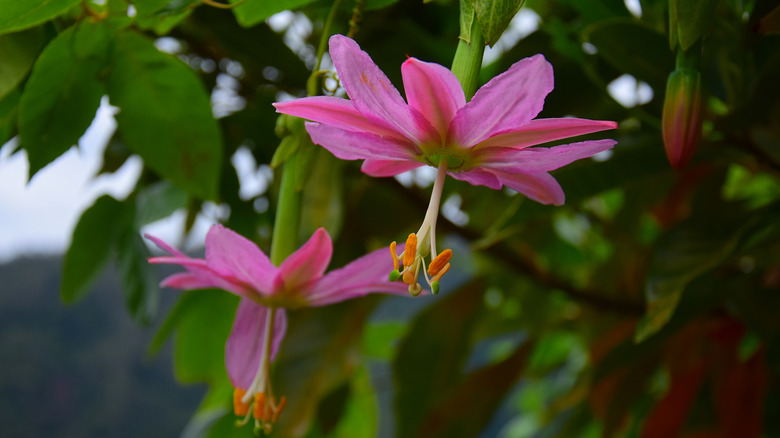The Illegal Fruit That Looks Like A Banana And Smells Like An Orange
If you're into tropical fruits, the little-known banana passionfruit sounds like a dream hybrid. Despite the name, it's not a mix of two fruits at all. Once mature, the banana passionfruit looks like a small banana, but when it's cut open, you won't find a creamy, pale yellow interior, but rather, a glistening trove of black-flecked, orange-colored arils that resemble other types of passionfruit. The pulp is sweet, juicy, and delightfully tangy. The fruit grows on vines that can climb beautifully on fences and trellises and produce eye-catching bright pink flowers. However, this beauty can become quite the beast, which is why it's become outlawed in certain places, like New Zealand.
Because the plant grows so quickly and robustly (vines can reach 30 feet if not tended to), it has a tendency to choke the host trees it climbs on, blocking sunlight and killing them. For this reason, some subtropical and tropical regions where the fruit would grow well have provisions against cultivating the plant. With that said, the seeds and plants are readily available to purchase online, so people with a green thumb can grow the fruit in their own backyards if they want. Just be mindful of your other greenery if you choose to plant this pushy tropical fruit.
What do they taste like?
Although you might be tempted to peel a banana passionfruit the way you would a banana, the best way to dig into these tasty fruits is to cut them open lengthwise. Doing so will reveal two halves full of tempting, juicy flesh that you can scoop out with a spoon and eat on its own or use in recipes. Interestingly, banana passionfruits have a bright, orange-like aroma, but the flavor is reminiscent of melon or peaches. They are sweet with a good bit of acidity, and while the black seeds are completely edible, they can taste bitter when chewed.
You can use the pulp just like you'd use the flesh from a standard passionfruit. Spoon it over yogurt, puddings, and ice cream; use it in baked goods (it would taste great in a hummingbird cake or carrot cake), smoothies, jams and jellies, salad dressings, juices, iced teas, and lemonades. Banana passionfruit has a flavor that would be delightful in cocktails. Start by making a syrup from the pulp and strain out the seeds. The flavor plays well with vodka, rum, and gin-based drinks; it will take a Tom Collins to another level of excitement. And anything with a tropical vibe, like a piña colada, will naturally mesh with the essence of banana passionfruit.
Where can you find them?
This isn't a fruit you can pick up regularly at your local supermarket in most parts of the United States. Banana passionfruit grows natively in Ecuador, Peru, Colombia, Venezuela, and Bolivia. It grew wild until just before European explorers arrived on the continent in the 15th century; in the 1400s, the plant and fruit began to be cultivated intentionally by local people. In the 19th century, banana passionfruit was brought to New Zealand, where it grew a little too well, killing native species of plants and quickly becoming out of control, leading the plant to be labeled as "invasive." It's now illegal to grow, sell, and distribute the fruit in the country.
Similar situations in Australia and Hawaii led to the plant being problematic. In Hawaii, the plant is prohibited by the state's Department of Agriculture, though it grows wild as an invasive species there. In Australia, banana passionfruit is considered a weed, but it doesn't appear to be outright banned. Banana passionfruit can grow in California, Africa, Asia, and the Mediterranean regions, but it takes a lot of care and attention to keep the plants under control, and regular pruning is required to keep them from taking over other plants and greenery.


